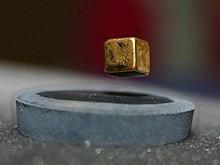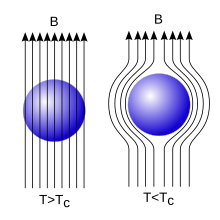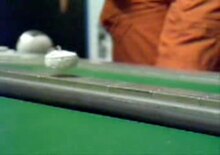Meissner-Ochsenfeld effect
The Meißner-Ochsenfeld effect is the property of superconductors in the Meißner phase ( superconductors of the first type ) to completely displace an externally applied magnetic field from their interior. The superconductor is therefore not only an ideal conductor, but also an ideal diamagnet . This effect was discovered in 1933 by Walther Meißner and Robert Ochsenfeld and can not be explained by classical physics . The macroscopic theoretical explanation of the Meissner-Ochsenfeld effect is provided by the London equations .

Basics
The Meißner-Ochsenfeld effect is a very characteristic property of superconductors. The external magnetic field penetrates about 100 nm far into the material, deeper layers are field-free. This “pushing out” of the magnetic field is independent of whether the sample was already superconducting before the magnetic field was switched on or is only made superconducting after the magnetic field has been switched on (see section Difference to the ideal conductor ).
Gabriel Lippmann has already demonstrated in classical electromagnetism that the magnetic flux through an ideal conductor is constant, which explains that if there was no magnetic field in the conductor before the ideal conduction state was created, it must still be free of magnetic fields in the ideal conduction state. The “pushing out” of the magnetic field when the material becomes superconducting is not explained in the classic way.
The superconducting state is often demonstrated by the Meißner-Ochsenfeld effect and not by the disappearance of the electrical resistance. It is also noteworthy that the effect does not depend on the history of the material; it is therefore reversible in the language of thermodynamics . Meißner and Ochsenfeld have thus indirectly demonstrated that the superconducting state is a real thermodynamic state .
All superconductors show a complete Meissner-Ochsenfeld effect as long as the temperature does not exceed the critical temperature and the externally applied magnetic field remains below a critical field strength . Because of the complete field displacement, one also speaks of perfect diamagnets . Superconductors of the second type only show an incomplete Meissner-Ochsenfeld effect above a critical field strength : in this so-called Schubnikow phase, the magnetic field penetrates the superconductor within thin tubes, so-called flux tubes , which are arranged in an equilateral triangular grid. In this phase the superconductor is no longer a perfect diamagnet; But it is still superconducting.
In the case of workpieces that are not too thin, the Meißner-Ochsenfeld effect depends on the purity and homogeneity of the superconductor. A complete Meissner-Ochsenfeld effect only occurs when the entire sample has become superconducting. Otherwise mixed states of normal and superconducting areas can develop. The Meißner-Ochsenfeld effect is therefore suitable for assessing the quality of a superconductor. In contrast, the electrical resistance is practically zero as soon as the temperature falls below the critical temperature .
Simplified explanation
A much simplified explanation is:
The interface is approximated by the plane x = 0. To the left of the interface, i.e. H. for x <0, there is normally conducting material and a homogeneous, vertical magnetic field B z . To the right of the interface, i.e. H. for x> 0, the material is superconducting. Then along the boundary surface, in a very thin surface layer of width λ (“penetration depth”), the exact extent of which can also be calculated, supercurrents j y directed from front to back flow . According to the “ right-hand rule ”, these generate a vertically downwardly directed magnetic field which precisely compensates for the vertically upwardly directed external magnetic field B z in order to minimize the field energy.
So in the superconductor - apart from the mentioned surface layer of width λ - B = 0 everywhere.
Difference from the ideal ladder
If a plate of an ideal conductor (a material without electrical resistance) is lowered onto a permanent magnet, according to Lenz's rule, currents are induced in the plate , which counteract the magnetic field and thereby allow the plate to float above the magnet. Since there is no resistance, the currents are not weakened and the plate floats permanently. In the case of a superconductor, its electrical resistance disappears below the critical temperature and it becomes the ideal conductor. This is why a superconductor plate hovers over a magnet if it has previously been cooled to below its critical temperature.
But the properties of a superconductor go beyond those of an ideal conductor. This can be shown by reversing the order of the experiment: If you place the (warm) superconductor plate on the magnet and only then cool it down, it begins to hover below the critical temperature. With a classic ideal conductor, nothing would happen, that is, this so-called Meißner-Ochsenfeld effect is a special property of superconductors. The effect can be explained by the fact that shielding currents form during the phase transition to the superconducting state, which displace the magnetic field from the interior of the superconductor.
Applications
The Meißner-Ochsenfeld effect is used, for example, in superconducting magnetic bearings or in superconducting switches, so-called cryotrons .
The explanation of the Meißner-Ochsenfeld effect in the form of the Ginsburg-Landau theory serves as a model for the so-called Higgs mechanism , through which the mass of the exchange particles of the electroweak interaction is generated in high-energy physics .
literature
- Walther Meißner, Robert Ochsenfeld: A new effect when superconductivity occurs . In: Natural Sciences . tape 21 , no. 44 , 1933, pp. 787-788 , doi : 10.1007 / BF01504252 .
- Horst Stöcker: Pocket book of physics. 4th edition, Verlag Harry Deutsch, Frankfurt am Main 2000, ISBN 3-8171-1628-4
Individual evidence
- ↑ Ludwig Bergmann, Clemens Schaefer: Textbook of Experimental Physics . Solid. 2nd Edition. tape 6 . de Gruyter, 2005, ISBN 3-11-017485-5 ( limited preview in Google Book Search [accessed on July 6, 2014]).
- ↑ u. a. G. Lippmann: Sur les propriétés des circuits électriques dénués des résistance . In: Comptes rendus . tape 168 , 1919, pp. 73-78 .
- ↑ Reinhard Strehlow: Fundamentals of Physics: For natural scientists and engineers . Springer, 2013, ISBN 3-322-80283-3 , pp. 360 ( limited preview in Google Book Search).




